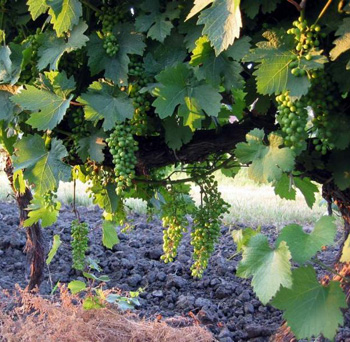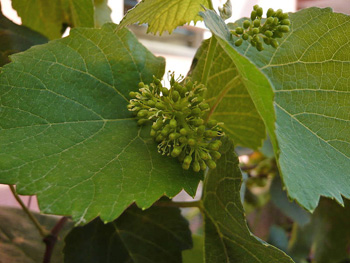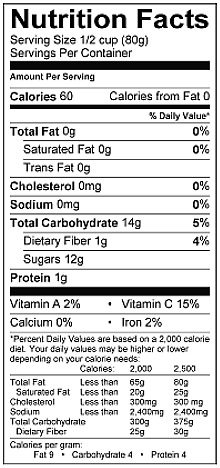Contents:
Common Names | Parts Usually Used | Plant(s) & Culture | Where Found | Medicinal Properties | Biochemical Information
Legends, Myths and Stories | Uses | Formulas or Dosages | Nutrient Content | How Sold | Warning | Resource Links | Bibliography
Scientific Names

- Vitex vinifera L.
- Vitaceae
- Grape family
Common Names
- Dark grape
- Fox grape
Parts Usually Used
Fruits and leaves
Back to Top

Description of Plant(s) and Culture
Everyone is familiar with the grape vine. The following information pertains to the dark grape species.
Grapevines supported on old-fashioned arbors and grown with special pruning methods produce more fruit than those grown on conventional wire training trellises. The top-area is exposed to more sunlight and the pruning secret is to take out some of the hard stems, and to pick off from a third to a half of the small bunches of grapes before they use up too much of the available plant food. Experts have found that more foliage means bigger, better-flavored grapes.
Another variety: the fox grape (Vitis labrusca) is a high-climbing liana vine. Leaves rounded in outline, heart-shaped at base; 3-lobed, toothed, with dense whitish to reddish felt beneath. Fruits about 20 purple-black (or amber white) grapes in a cluster around September to October.
Back to Top
Where Found
Found in thickets, woods; southern Maine to Georgia; Tennessee to Michigan. Widely cultivated.
Back to Top
Medicinal Properties
Nutritive, diuretic
Back to Top
Biochemical Information
Vitamins A, B, C, dextrose, fructose, pectin, tartaric and malic acids, mineral salts, tannin, flavone, glycosides and pigment, magnesium, potassium, iron, niacin, riboflavin, carbohydrates
Back to Top
Legends, Myths and Stories
In the reference book, 50 Years Anthology; The Herbalist Almanac, written by Clarence Meyer, edited by David C. Meyer, in memory of Joseph E. Meyer, “the Herb Doctor”, there is a small paragraph that seems apt here. This quote is reported to have come from the 1585 edition of Dodoens’ A Nievve Herball or Historie of Plantes.
Quote: “I will touch onely the particular properties of wine it selfe, both as it is medicinable and nourishing, for taken moderately, and by them that are of a middle age, or well stept in yeares, or are of a cold and dry disposition and (not very young, and so their blood too hot for to abide wine) it encreaseth blood and nourisheth much: it procureth an appetite, and helpeth to digest being taken at meate (meals)–it expelleth feares, cares, and heavinesse, and breedeth alacrity, mirth and bodily pleasure–causeth quiet rest and sleepe, both to the sound and sicke that lacke it–on the contrary side, the excess thereof breedeth a distraction in the sense, the Appoplexie, and Lethargy or drowsie evill, the trembling of the joynts, the palsie, and the dropsie.”
Back to Top
Uses
Treats blood and energy deficiency, night sweats, thirst, palpitations, rheumatic pains, difficult urination, edema, dry cough.
Wild or cultivated whole grape leaves were put in the bottom of crocks to preserve the color of beans that were stored. Grape leaves also used to wrap fresh-made butter. Said to help preserve butter. Cultivated grape leaves considered best.
Vitis labrusca (fox grape) was used by the Native Americans as leaf tea for diarrhea, hepatitis, stomachaches, thrush. Externally, they poulticed wilted leaves for sore breasts, rheumatism, headaches, fevers. Other Vitis species have been used similarly. Vines, when cut in the summer, yield potable water, possibly purer than today’s acid-rain water.
Back to Top
Formulas or Dosages
Drink the fresh juice of the fruit.
According to one reference if grape juice is taken four times each day; 1 oz. in plain water and 3 oz. grape juice, taken 1/2 hour before each meal and upon retiring, then the matter of dieting will take care of itself. The only restrictions as far as diet is concerned, should be sweets, chocolate; great quantities of sugars, pastries. But all other foods, vegetables, and meats, provided they are not fats, may be taken according to the appetite; but the appetite will change a great deal. Obesity will regulate itself when this is done regularly.
Back to Top
Nutrient Content
Magnesium, potassium, iron, niacin, riboflavin, vitamins A, B, C, dextrose, fructose

How Sold
Supermarket
Back to Top
Warning
Do not confuse the fox grape vine with Canada Moonseed (Menispermum canadense), which is considered toxic.
Back to Top
Resource Links
LiveStrong.com: What Are the Benefits of Red Wine Extract?
MayoClinic.com: Red wine and Resveratrol: Good for Your Heart?
Memorial Sloan-Kettering Cancer Center: Resveratrol
Linus Pauling Institute: Resveratrol
Drugs.com: Health Secrets of Red Wine Uncovered
Bibliography
![]() American Folk Medicine
American Folk Medicine, by Clarence Meyer, Meyerbooks, publisher, PO Box 427, Glenwood, Illinois 60425, 1973
![]() Eastern/Central Medicinal Plants
Eastern/Central Medicinal Plants, by Steven Foster and James A. Duke., Houghton Mifflin Company, 215 Park Avenue South, New York, NY 10000
![]() The Herbalist Almanac
The Herbalist Almanac, by Clarence Meyer, Meyerbooks, publisher, PO Box 427, Glenwood, Illinois 60425, copyright 1988, fifth printing, 1994
![]() The Herb Book
The Herb Book, by John Lust, Bantam Books, 666 Fifth Avenue, New York, NY. copyright 1974.
 The Magic of Herbs in Daily Living
The Magic of Herbs in Daily Living, by Richard Lucas, Parker Publishing Co. (1988).
 How Indians Use Wild Plants for Food, Medicine & Crafts
How Indians Use Wild Plants for Food, Medicine & Crafts, by Frances Densmore, Dover Publications, Inc., 180 Varick Street, New York, NY 10014, first printed by the United States Government Printing Office, Washington, in 1928, this Dover edition 1974
![]() Indian Uses of Native Plants
Indian Uses of Native Plants, by Edith Van Allen Murphey, Meyerbooks, publisher, PO Box 427, Glenwood, Illinois 60425, copyright 1958, print 1990
 Old Ways Rediscovered
Old Ways Rediscovered, by Clarence Meyer, Meyerbooks, publisher, PO Box 427, Glenwood, Illinois 60425, published from 1954, print 1988
![]() Planetary Herbology
Planetary Herbology, by Michael Tierra, C.A., N.D., O.M.D., Lotus Press, PO Box 325, Twin Lakes. WI 53181., Copyright 1988, published 1992
![]() The Yoga of Herbs: An Ayurvedic Guide to Herbal Medicine
The Yoga of Herbs: An Ayurvedic Guide to Herbal Medicine, by Dr. David Frawley & Dr. Vasant Lad, Lotus Press, Twin Lakes, Wisconsin, Second edition, 1988.
![]() Webster’s New World Dictionary
Webster’s New World Dictionary, Third College Edition, Victoria Neufeldt, Editor in Chief, New World Dictionaries: A Division of Simon & Schuster, Inc., 15 Columbus Circle, New York, NY 10023
 The Rodale Herb Book: How to Use, Grow, and Buy Nature’s Miracle Plants (An Organic gardening and farming book)
The Rodale Herb Book: How to Use, Grow, and Buy Nature’s Miracle Plants (An Organic gardening and farming book), edited by William H. Hylton, Rodale Press, Inc. Emmaus, PA, 18049., 1974
